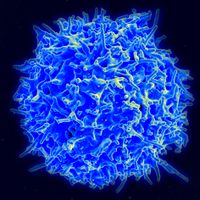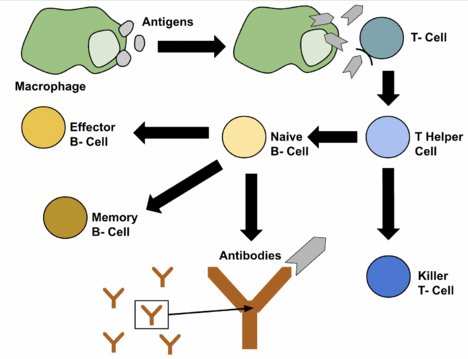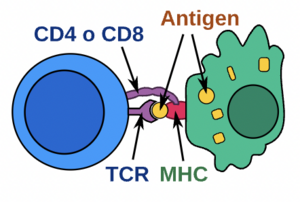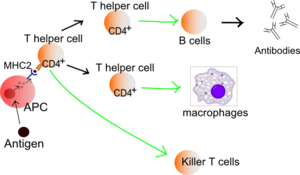T Cells: Difference between revisions
No edit summary |
No edit summary |
||
| Line 17: | Line 17: | ||
* CD8+ T Cells (cytotoxic T cells, or killer T cells): actively destroy infected cells through the use of granule sacs that contain digestive enzymes. | * CD8+ T Cells (cytotoxic T cells, or killer T cells): actively destroy infected cells through the use of granule sacs that contain digestive enzymes. | ||
* CD4+ T cells (helper T cells): activate cytotoxic T cells, macrophages, and stimulate antibody production by B cell lymphocytes. A CD4 count is used to check the health of the immune system in people infected with [[HIV/AIDS|HIV]] (human immunodeficiency virus). HIV attacks and destroys CD4 cells<ref>Midline plus CD4+ Lymphocyte count | * CD4+ T cells (helper T cells): activate cytotoxic T cells, macrophages, and stimulate antibody production by B cell lymphocytes. A CD4 count is used to check the health of the immune system in people infected with [[HIV/AIDS|HIV]] (human immunodeficiency virus). HIV attacks and destroys CD4 cells<ref>Midline plus CD4+ Lymphocyte count Available: https://medlineplus.gov/lab-tests/cd4-lymphocyte-count/ (accessed 3.8.2022)</ref>.<ref /> | ||
* Regulatory T cells (also called Tregs): suppress the actions of B and T cells to decrease the immune response when a highly active response is no longer warranted. Tregs control the immune response to self and foreign particles (antigens) and help prevent autoimmune disease.<ref>BS of immunology T regulatory cells (Trega) Available: https://www.immunology.org/public-information/bitesized-immunology/cells/regulatory-t-cells-tregs ( accessed 3.8.2022)</ref> | * Regulatory T cells (also called Tregs): suppress the actions of B and T cells to decrease the immune response when a highly active response is no longer warranted. Tregs control the immune response to self and foreign particles (antigens) and help prevent autoimmune disease.<ref>BS of immunology T regulatory cells (Trega) Available: https://www.immunology.org/public-information/bitesized-immunology/cells/regulatory-t-cells-tregs ( accessed 3.8.2022)</ref> | ||
* Natural Killer T cells: distinguish infected or cancerous cells from normal body cells and attack cells that do not contain molecular markers that identify them as body cells. | * Natural Killer T cells: distinguish infected or cancerous cells from normal body cells and attack cells that do not contain molecular markers that identify them as body cells. | ||
Revision as of 02:09, 4 August 2022
Original Editor - Lucinda hampton
Top Contributors - Lucinda hampton and Vidya Acharya
Introduction[edit | edit source]
T lymphocytes are a critical part of the adaptive immune system safeguarding against infection and malignancy, but also implicated in many immune pathologies.[1] T cells arise from bone marrow and mature in the thymus. The thymus is a lymphatic system gland that functions principally to support the development of mature T cells (the "T " in T cell lymphocyte stands thymus derived).
T cell lymphocytes are different from B cell lymphocytes and natural killer cells in that they have a protein called a T-cell receptor on their cell membrane.
Types[edit | edit source]
There are various types of T cells namely:
- Naive T cell: T cell that has matured and been released by the thymus but has not yet encountered its corresponding antigen, that is they are in the stage between maturity and activation. Each naïve T cell has a unique T cell receptor that recognizes a specific antigen, and once they encounter their antigen specific the activation of naïve T cells will begin.[2]
- CD8+ T Cells (cytotoxic T cells, or killer T cells): actively destroy infected cells through the use of granule sacs that contain digestive enzymes.
- CD4+ T cells (helper T cells): activate cytotoxic T cells, macrophages, and stimulate antibody production by B cell lymphocytes. A CD4 count is used to check the health of the immune system in people infected with HIV (human immunodeficiency virus). HIV attacks and destroys CD4 cells[3].Cite error: The opening
<ref>tag is malformed or has a bad name - Regulatory T cells (also called Tregs): suppress the actions of B and T cells to decrease the immune response when a highly active response is no longer warranted. Tregs control the immune response to self and foreign particles (antigens) and help prevent autoimmune disease.[4]
- Natural Killer T cells: distinguish infected or cancerous cells from normal body cells and attack cells that do not contain molecular markers that identify them as body cells.
- Memory T cells: protect against previously encountered antigens and may provide lifetime protection against some pathogens[5].
Major Histocompatibility Complex (MHC)[edit | edit source]
T cells cannot recognize soluble, free antigens, they can only recognize protein-based, receptor-bound antigens. This recognition occurs via the use of the MHC also known as HLA(human leucocyte antigen) 1 and 2 receptors, which along with the T-cell receptors bind the antigen it seeks and form a complex that allows the T cell to remember the antigen. The T-cell receptor is a protein complex found on the surface of T cells that is responsible for recognizing fragments of antigen as peptides bound to major histocompatibility complex (MHC) molecules, and are not found on B cells.[1]
MHC molecules are important components of the immune system, allowing T lymphocytes to detect cells, for example macrophages, that have ingested infectious microorganisms. The macrophage engulfs a microorganism and partially digests it and displays peptide fragments of the microbe on its surface, bound to MHC molecules. The T lymphocyte identifies the foreign fragment attached to the MHC molecule and binds to it, arousing an immune response. In uninfected healthy cells, the MHC molecule presents peptides from its own cell (self peptides), to which T cells do not normally react.[6]
Sub Heading 2[edit | edit source]
Sub Heading 3[edit | edit source]
Resources[edit | edit source]
- bulleted list
- x
or
- numbered list
- x
References[edit | edit source]
- ↑ 1.0 1.1 Dimeloe S, Burgener AV, Grählert J, Hess C. T‐cell metabolism governing activation, proliferation and differentiation; a modular view. Immunology. 2017 Jan;150(1):35-44. Available: https://www.ncbi.nlm.nih.gov/pmc/articles/PMC5341500/(accessed 3.8.2022)
- ↑ Akedeum Naive T cells Available: https://www.akadeum.com/blog/what-are-naive-cells/ (accessed 3.8.2022)
- ↑ Midline plus CD4+ Lymphocyte count Available: https://medlineplus.gov/lab-tests/cd4-lymphocyte-count/ (accessed 3.8.2022)
- ↑ BS of immunology T regulatory cells (Trega) Available: https://www.immunology.org/public-information/bitesized-immunology/cells/regulatory-t-cells-tregs ( accessed 3.8.2022)
- ↑ Thought Co Available T cells:https://www.thoughtco.com/t-cells-meaning-373354 (accessed 3.8.2022)
- ↑ Britannica MHC Available:https://www.britannica.com/science/major-histocompatibility-complex (accessed 3.8.2022)










